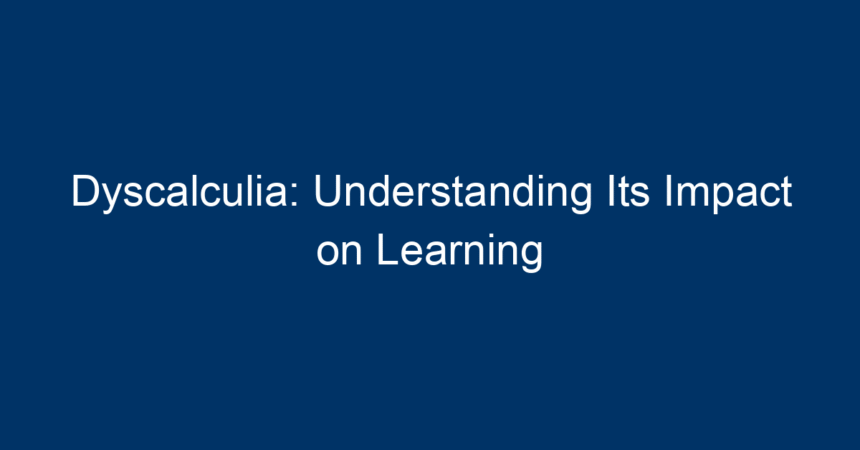Understanding learning disabilities is crucial for fostering an inclusive educational environment. Among these disabilities, dyscalculia stands out as one that affects many learners but often remains misunderstood. Dyscalculia, often referred to as “math dyslexia,” is a specific learning disability that impacts an individual’s ability to understand numbers and learn math concepts. This comprehensive article delves into the intricacies of dyscalculia, its effects on learning, and practical strategies to support affected learners.
What is Dyscalculia?
Dyscalculia is defined as a neurological condition that results in difficulties with numeracy and mathematical reasoning. Estimates suggest that up to 7% of the population may be affected by dyscalculia, making it as prevalent as dyslexia. While dyscalculia can impact individuals of any age, it is often identified during elementary school when foundational math skills are being developed.
Characteristics of Dyscalculia
Individuals with dyscalculia may exhibit a range of characteristics, including:
- Difficulty understanding number concepts: Struggling to grasp the meaning of numbers or their relationships.
- Problems with mathematical operations: Challenges with basic arithmetic operations such as addition, subtraction, multiplication, and division.
- Issues with spatial awareness: Difficulty in understanding shapes, directions, and the spatial arrangement of numbers.
- Struggles with sequences and patterns: Trouble identifying and replicating numerical sequences or mathematical patterns.
Recognizing these characteristics early can facilitate timely interventions to support affected students better.
The Impact of Dyscalculia on Learning
Academic Challenges
The most apparent impact of dyscalculia is on a student’s academic performance, particularly in math-related subjects. Students may experience:
- Low confidence: Continuous struggles with math can lead to diminished self-esteem and a fear of math-related tasks.
- Avoidance behavior: Many students may develop avoidance strategies, steering clear of situations involving numbers or math.
- Lower academic performance: These challenges often translate into lower grades, particularly in math and science courses, which rely heavily on numerical skills.
Emotional and Social Effects
Dyscalculia isn’t solely an academic issue; its effects extend into emotional and social realms. Students with dyscalculia may encounter:
- Anxiety and frustration: The frequent struggle with math can lead to heightened anxiety in academic settings.
- Isolation: A lack of understanding from peers and teachers can result in feelings of loneliness and misunderstanding, pushing students away from social involvement.
- Negative self-image: Over time, students may internalize the belief that they are "bad" at math, negatively impacting their overall self-worth.
Real-Life Implications
The challenges associated with dyscalculia do not end in the classroom. Individuals with dyscalculia may find everyday situations, such as budgeting, managing time, or even following directions, particularly daunting. This can have serious implications for their independence and overall quality of life.
Identifying Dyscalculia
Early identification is key to supporting students with dyscalculia effectively. Educators and parents should look for specific indicators that suggest a student may be struggling with dyscalculia:
- Frequent errors in simple calculations: Even with basic math problems, students might make consistent mistakes.
- Difficulty in learning math facts: Some students may struggle to memorize numerical facts or make connections between them.
- Difficulty understanding time and money: Struggling to tell time, manage finances, or calculate change are common signs.
It is vital for parents and educators to approach these signs with empathy and encourage appropriate assessment from educational psychologists or specialists.
Strategies for Supporting Students with Dyscalculia
Supporting students with dyscalculia involves a multi-faceted approach tailored to their individual needs. Here are some effective strategies:
Use Visual Aids
Visual aids are invaluable tools for students with dyscalculia. Incorporating drawing, physical objects, or technology like apps can help make abstract concepts more tangible. For example:
- Counters and blocks: Using physical counting aids can help students visualize math problems.
- Graphic organizers: Flowcharts can help break down multi-step problems, making them easier to understand.
Incorporate Multi-Sensory Learning
Incorporating multi-sensory techniques can enhance the learning experience. Utilizing visual, auditory, and kinesthetic approaches can help engage students better. This might involve:
- Listening to math-related songs: Music can assist with memorization of math facts.
- Interactive games: Gamified learning tools can make math fun and relatable.
Build a Positive Learning Environment
Creating a supportive classroom atmosphere is crucial. Educators should:
- Celebrate small victories: Acknowledge improvements and effort, no matter how minor.
- Encourage questions: Foster an environment where students feel comfortable asking for help.
- Reduce pressure: Allow more time for assessments and assignments, minimizing stress and anxiety.
Develop Individualized Learning Plans
For students with dyscalculia, an Individualized Education Plan (IEP) may be necessary. Collaborate with special educators to create tailored strategies, incorporating remedial math programs, specialized tutoring, and adaptive learning materials.
Conclusion
Dyscalculia is a significant learning disability that can profoundly affect an individual’s academic journey and self-esteem. However, with early identification and the right support strategies, students can overcome these challenges and thrive in their educational environments. By fostering a supportive atmosphere and understanding the complexities of dyscalculia, we can help learners navigate their struggles and cultivate a lifelong affinity for learning.
If you suspect that you or someone you know may be experiencing the effects of dyscalculia, it’s essential to seek assessment and support. By advocating for understanding and intervention, we can create a more inclusive educational landscape, ensuring that every learner has the opportunity to succeed regardless of their mathematical abilities.




